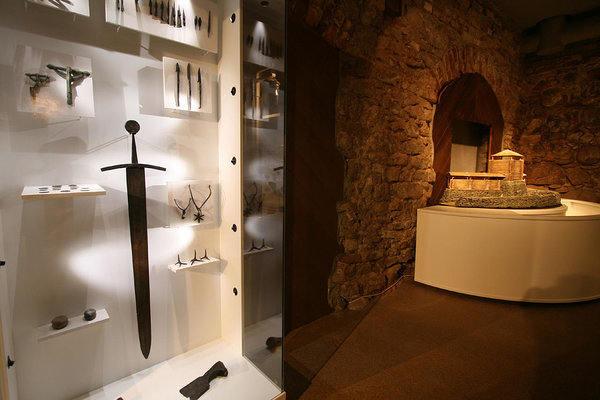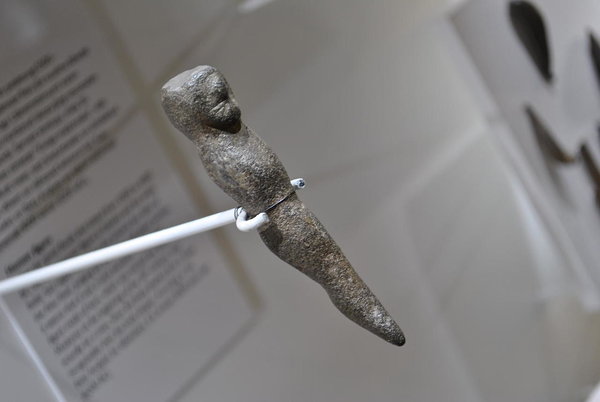Pärnu Museum was founded by Society of Archaeology (Pernauer Alterthumforschende Gesellschaft) of the Baltic Germans who were history enthusiasts. Society was established in 1896 and its aim was to study, present and preserve local history. On November 3th, 1896 at the first general meeting of Society of Archaeology it was decided to open the collection which was grown both through donations and purchases to a wider audience.
Thus a museum, previously available only to a narrow circle of people, in 1909, moved into the building located at the address Elevandi 7. This building burned down in September 1944, during World War II. Fire severely damaged a collection and many unique items were destroyed. However, most of the items were hidden outside of the town and were therefore saved.
In 1939-1940, Society of Archaeology did not last due to leaving of the Baltic Germans (Umsiedlung) and they had to transfer the artifacts to the possession of a new specially created society.
In October 1940, museum collections were nationalized by the Soviet government. Since 1944, after the Soviet occupation of Estonia, the museum was relocated into two-story brick building Aia 4. This house was built for commercial space on the ground and living quarters on the second floor. The house was rebuilt in accordance with the museum requirements at the time.
On September 22th, 1971, a new permanent exhibition was opened. Already at that time, there was too little space for the museum's needs and collection. Museum's collection had grown to 83,160 items plus the material accumulated in recent years in the course of archaeological fieldwork.
A renovated storehouse of the XIX century on the banks of the river Pärnu at 3 Aida became a new location of the museum. Updated Pärnu Museum offers both traditional and interactive solutions in order to enable visitors to go through all 11,000 years of Estonian history from the time of Early Mesolithic settlement, learn about the life of aristocrats having a good time and about the proclamation of the Republic of Estonia, as well as get acquainted with the lifestyles of Hanseatic city.
In addition to exhibits, the museum has a whole floor for temporary exhibitions and a plenty entertainment for the whole family!
In 1939-1940, Society of Archaeology did not last due to leaving of the Baltic Germans (Umsiedlung) and they had to transfer the artifacts to the possession of a new specially created society.
In October 1940, museum collections were nationalized by the Soviet government. Since 1944, after the Soviet occupation of Estonia, the museum was relocated into two-story brick building Aia 4. This house was built for commercial space on the ground and living quarters on the second floor. The house was rebuilt in accordance with the museum requirements at the time.
On September 22th, 1971, a new permanent exhibition was opened. Already at that time, there was too little space for the museum's needs and collection. Museum's collection had grown to 83,160 items plus the material accumulated in recent years in the course of archaeological fieldwork.
A renovated storehouse of the XIX century on the banks of the river Pärnu at 3 Aida became a new location of the museum. Updated Pärnu Museum offers both traditional and interactive solutions in order to enable visitors to go through all 11,000 years of Estonian history from the time of Early Mesolithic settlement, learn about the life of aristocrats having a good time and about the proclamation of the Republic of Estonia, as well as get acquainted with the lifestyles of Hanseatic city.
In addition to exhibits, the museum has a whole floor for temporary exhibitions and a plenty entertainment for the whole family!
Our pride and joy is the so-called 'Stone Age Madonna'. At more than 8000 years old, it is the oldest known human-shaped sculpture in the Scandinavia and Baltic Sea area. Other star attractions include a fragment of a 14th-century merchant ship and a glass floor that lets you look down onto archaeological remnants of one of the town's historic gates, which let through all the people and goods from New Pärnu port to the Hanseatic city.
Pärnu Museum has two branches. Memorial Museum of the Estonian poetess Lydia Koidula at 37 Jannseni, which is located in a school building, built in 1850 for Estonians of suburb on the right bank of Pärnu River. And medieval Red Tower at Hommiku 11, where you can get acquainted with the architecture of this ancient prison tower, the medieval town of New-Pärnu, and history of Pärnu.
To really understand Pärnu, you should start from the very beginning! Pärnu Museum, Koidula Museum and the Red Tower will take you on a journey through history, and with a combined ticket from Pärnu Museums you can really get to know your destination.
The combined ticket gives you the opportunity to visit all three branches of the museum once during one year - the main building of the Pärnu Museum in Aida 3, the medieval Red Tower in Hommiku 11 and the Koidula Museum in Jannsen 37.
BUY THE COMBINED TICKET FROM PRE-SALE
Pärnu Museum has two branches. Memorial Museum of the Estonian poetess Lydia Koidula at 37 Jannseni, which is located in a school building, built in 1850 for Estonians of suburb on the right bank of Pärnu River. And medieval Red Tower at Hommiku 11, where you can get acquainted with the architecture of this ancient prison tower, the medieval town of New-Pärnu, and history of Pärnu.
To really understand Pärnu, you should start from the very beginning! Pärnu Museum, Koidula Museum and the Red Tower will take you on a journey through history, and with a combined ticket from Pärnu Museums you can really get to know your destination.
The combined ticket gives you the opportunity to visit all three branches of the museum once during one year - the main building of the Pärnu Museum in Aida 3, the medieval Red Tower in Hommiku 11 and the Koidula Museum in Jannsen 37.
BUY THE COMBINED TICKET FROM PRE-SALE
-1.jpg)
.jpg)

